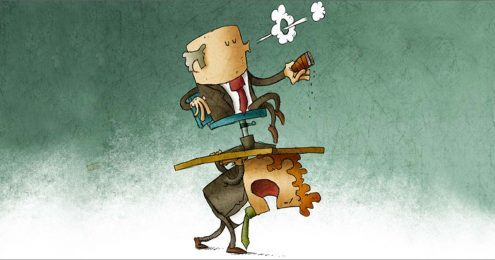In most companies, there is a hierarchy of power. Typically, the CEO is at the top and it goes down from there.
Nonprofits are different. There are a lot of power centers. The board. The staff. Donors. Volunteers. Clients. Constituents. And on and on.
Yes, the board does have the ability to hire and fire the CEO or Executive Director. But the best run nonprofits run like a twin-engine jet with the ED and board chair acting as co-pilots. Leadership is shared.
But that doesn’t mean all decisions get made in tandem. There are certain things the ED must handle and other things that are the purview of the board chair.
Today, I’m going to break it all down for you:
- The responsibilities of the Executive Director
- The responsibilities of the board chair
- The grey area where the two need to work together
Here we go…
FIRST, DOWNLOAD THE OVERVIEW
Before we dive into the details, for your convenience I’ve created a one-page overview of the roles of the board chair and Executive Director. My hope is that you’ll review it together at your next board meeting to help you get on the same page – and stay there.
Provide your email address and I’ll send it to your inbox with the subject line “Roles and Responsibilities.”
–> Click here to get the overview.
WHEN IS THE EXECUTIVE DIRECTOR IN CHARGE?
There are three key buckets into which E.D. decisions fall. The key words are: hiring, evaluating, managing, operationalizing. These are the places where the Executive Director should be running the show. And if the board chair is stepping into these places, she has overstepped her bounds. She is micromanaging. She risks demoralizing the Executive Director.
The board chair needs to keep an eye on all of it, communicate regularly, and file away observations and assessments about HOW the E.D. is handling these responsibilities in order to provide a detailed evaluation with lots of examples.
1) The Staff: Hiring, Management, and Supervision
Listen up board chairs: Who gets hired, how they are managed and evaluated, and whether they stay or go is the job of the E.D. Full stop.
What if a Board Chair sees that the E.D. has made a terrible hiring mistake or a staff member is going rogue?
Can she raise a concern? You bet.
Can she direct the E.D. to fire that person? Nope.
2) Managing to the Budget
The Executive Director needs to understand both the macro (what the numbers mean, trends, etc.) and has to manage the weeds.
The E.D. has to be on top of the numbers all the time. Even if there is a Director of Finance, your staff leader should understand what the numbers are saying, needs to be able to anticipate challenges, communicate them in a timely fashion, and in a way that all board members can understand.
3) Bring the Strategic Plan to Life
The Executive Director needs to develop and execute a set of annual goals aligned with the strategic plan, especially around program design, execution and success.
A presentation to the board at the start of each year and an explanation of how these goals will help achieve the overall goals of the plan are essential. Then the work, the “how,” the operationalizing of these goals, sits with the Executive Director.
WHEN IS THE BOARD CHAIR IN CHARGE?
The four key items listed below are led by the board chair and often, by virtue of regular communications with the E.D., the chair has the greatest amount of information and context to add.
1) Hiring and Evaluating The Executive Director
Board chairs can often have a tendency to swoop in and supervise rather than provide oversight or just simply assess as the year progresses. But “swooping” is a problem because it gives the board little opportunity to evaluate the E.D.’s performance fairly.
2) Approving Strategy
The board chair must ensure that there is a solid process in place and lead the board to approve a strategy that makes sense and can be owned and championed by all leaders in the organization.
3) Approving Annual Budget
While certainly not the sole responsibility of the chair, the chair must provide clear direction to the Finance Committee to create a process with integrity and to be sure that board members have what they need to make an informed decision as they vote.
4) Building a Strong and Accountable Board
The board chair is the coach of the board team. She is responsible for making sure that everyone plays by the rules and must hold each board member accountable to the vast array of responsibilities they have – from meeting attendance, to committee service, to fundraising.
In that spirit, the board chair is responsible for providing oversight to ensure a high performing governance function that evaluates board member performance and also identifies and recruits high quality board members.
HERE’S WHERE THE TROUBLE STARTS
So I’ve just identified the big things that are very clearly in one court or the other. Now I will say something that may annoy you:
Thought partners share and talk a lot before one or the other makes a decision that is rightfully theirs to make. This can easily turn black and white into gray.
For example:
Executive Director: I’m having a hard time with Sarah. I really think it might be time to let her go.
Board Chair Thought Balloon: WHAT HAVE YOU BEEN WAITING FOR? SARAH IS INCOMPETENT AND SCORCHING THE EARTH!
Mature Board Chair Response: I have seen some evidence that she is a challenge. Happy to offer some input here if you like. What do you need?
E.D. Thought Balloon: I really want to know but I sure don’t want my board chair in my staffing decisions.
Mature E.D. Response: Thanks. Your input would be helpful as I make a decision.
In this scenario, the mature Executive Director has alerted the co-pilot (the board chair) that she sees the storm ahead. The mature board chair has validated it and offered to be of help. The mature E.D. makes it clear that the decision is hers and that input would be of value.
The two of you need to approach BLACK & WHITE roles in just this way. Using words like “How can I be of help?” “ Would you like some input” “I’m struggling and interested in your point of view as I decide what path to take.”
Start practicing this kind of language. It is the language of co-pilots, the language of partners.
But there are still a few things that aren’t quite so black and white…
THE REAL HONEST-TO-GOODNESS GRAY AREAS
There are four places where the roles aren’t so clear. Where the decision making is way more joint that it is separate.
1) Board Composition
Stay with my airplane metaphor. Each co-pilot needs to care about both engines and the E.D. has to be engaged in the board engine in terms of defining the skills, attributes, and competencies that are most needed for the organization to thrive. No discussion of the ideal board should ever happen without the voice of the E.D. at the table.
2) Finding Great Board Members
Once you have built the model for your ideal board and have identified the gaps, the E.D. may in fact be your very best source of prospects and should be at the table regularly. In fact, the E.D. should have as close to a vote as you can get.
I used to frame it in the converse, talking about a kind of veto power. I could say something like, “I really can’t live with that candidate because…” and the board trusted and respected my point of view. It’s important that I made statements like these infrequently, reserving them for when I felt particularly strongly. But the truth is because I was an active part of the process all along the way, I hardly remember it ever coming to that.
3) Strategy Development
I’m working with a client now that has hit a difficult fork in the road. There seems to be two possible strategies to viability. The board chair and the E.D. are grappling with the fact that neither of them can live with one of the strategies. And the board has asked to review two budgets and will make a decision that will set the strategy in one of these two directions.
They are struggling – individually and as co-pilots.
Yes the planning process has been flawed here for sure. But my point is that the E.D. and the board chair must be completely in sync. They are flying in a bad storm and they need to be on the same page. They have turned to me to help them navigate together.
Strategy defines the organization in a profound way and in this endeavor, the E.D. and the board chair must work as partners. Because they lead together.
4) Board Engagement / Board Meetings
Board meetings are not a “necessary evil.” Not at all.
I see them as an organization’s best opportunity to enrich, inform, and engage board members so that they are ignited to invite folks to know and do more for your organization.
It is not just a meeting. It must be designed with intention to meet the bar I have just set.
And it must be more than a collection of business items. And that demands that the co-pilots plan it together. What do we want to accomplish? What does the board need? What does the board need to do? What does it need from the staff to deliver? What is the staff able to deliver?
This is the work of partners.
And so I hope this clarifies the roles of the staff and board leaders. It’s a lack of clarity on this that makes too many nonprofits less effective than they could be. The relationship between the board chair and CEO is critical. In fact, I often say that relationship is the single most critical sign of a healthy nonprofit.
NEXT STEPS
As I mentioned above, for your convenience I created a one-page overview of the roles of the board chair and Executive Director. My hope is that you’ll review it together at your next board meeting to help you get on the same page – and stay there.
Provide your email address and I’ll send it to your inbox with the subject line “Roles and Responsibilities.”




Joan, sometimes I think you must have a wiretap on my phone! Thank you for writing the perfect blog posts at the perfect time. I was just elected to be board chair of a nonprofit theater south of Boston. The first thing I did when I was asked to consider this role was give the E.D. your book to see if she was looking for a co-pilot. Now I will be able to share this one pager with the entire board at our January meeting. THANK YOU!
Joan…I am living the nightmare of a Board President who fails to lead. Her failure to lead the Board is filled in with her desire to micromanage everything that happens at the office. We have lost 5 Board members and the remaining Directors want her out, but do not want to do anything about it. After I called her out at a Board meeting for not following financial policies established by the Finance Committee, she has decided to not renew my employment contract, this spring. (Please excuse my lack of signature as she wants me to sign a confidentiality agreement) Understanding roles and responsibilities are key to making a nonprofit healthy, productive and thriving.
Her version of collaboration was to call me – several times a day – and tell me what she wanted done. There was no strategic plan, there was no long-term goals, budgeting had no achievable goals, fund-raising was all mine and mine alone and, in the end, when I confronted her with these issues, she reprimanded me. When I handed her materials from BoardSource about Board leadership, she became indignant.
Some people are simply not meant to be leaders of Boards. It takes skill, effort and a mindset of collaboration.
Thank you for your post!! I hope it inspires and uplifts those brave and sincere leaders who are in it for all the right reasons.